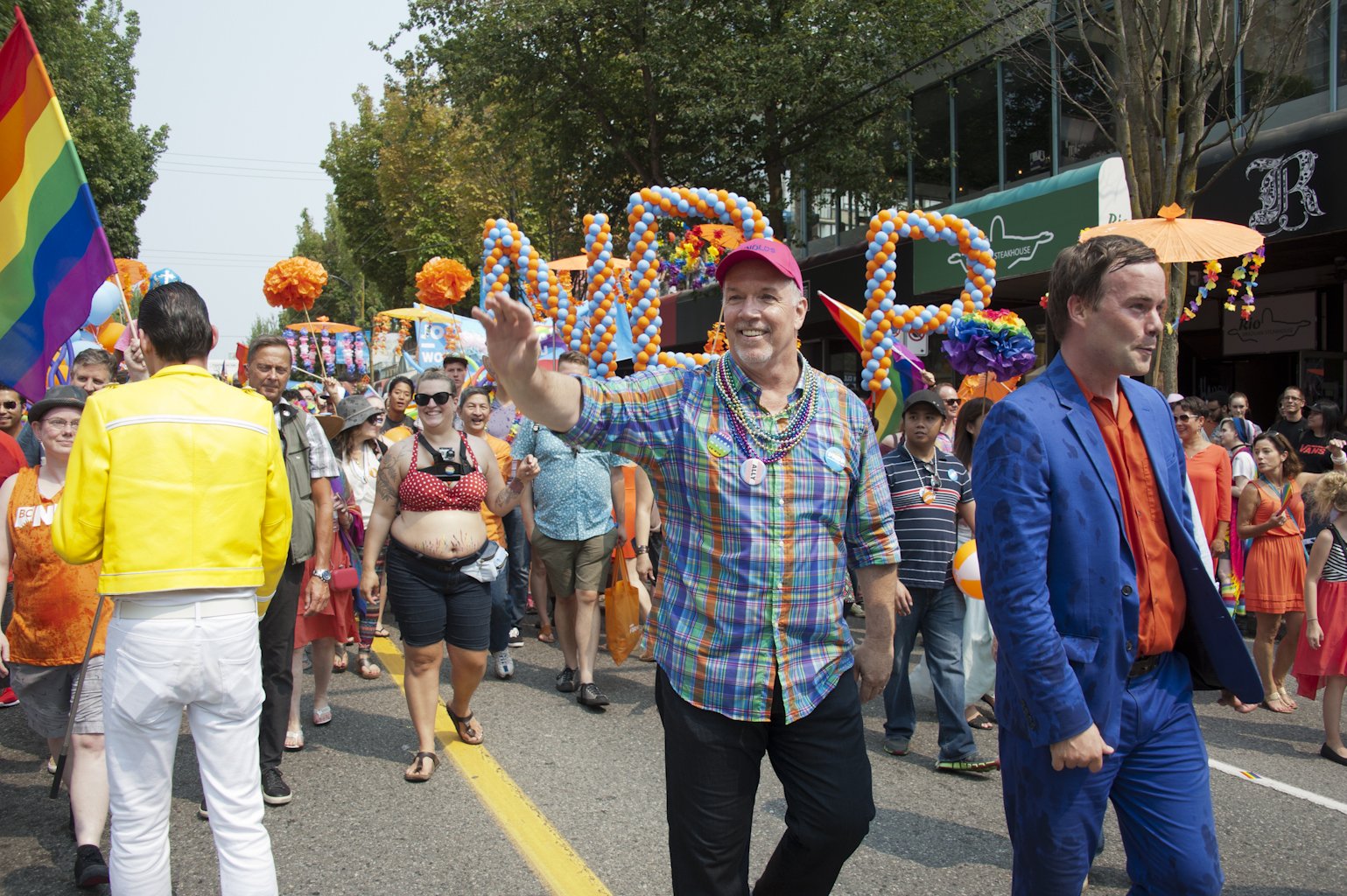As Vancouverites and visitors lined the route to cheer on the 2017 Vancouver Pride parade on Aug 6, 2017, many wondered what happened to the prime minister, whose absence did not go unnoticed.
To the dismay of many, Justin Trudeau was a no-show, despite being hugely popular with crowds last year when he became Canada’s first sitting prime minister to walk in Vancouver’s Pride parade.
According to CBC, Trudeau is in BC and yesterday was meeting with Indigenous leaders on Vancouver Island.

A sea of rainbow fills the parade route. Credit: InkedKenny/Xtra
Eleanore Catenaro, press secretary for the prime minister’s office, says Trudeau “unfortunately could not attend Vancouver Pride this year.”
“The Prime Minister is participating in many events to celebrate Pride across the country this summer, and felt it was particularly important to attend smaller parades that he hadn’t been to before, such as the recent Halifax Pride Parade,” Catenaro says in an Aug 6 email to Xtra.

The Vancouver Men’s Chorus at Pride. Credit: InkedKenny/Xtra
But Trudeau’s special advisor for LGBTQ2 issues, Randy Boissonnault, attended, Catenaro points out in her email.
Though the prime minister was absent, his national defence minister, Harjit Sajjan, not only attended but danced briefly on the float of Sher Vancouver, a local support group for LGBT Sikh and South Asian people. And Hedy Fry, the Liberal MP for Vancouver Centre, marched dressed as a warrior.
BC’s new premier, John Horgan, also marched with a sizeable contingent of supporters and NDP MLAs, marking the first time since 2013 that the province’s premier has marched in the Pride parade.
Watch our live video of the entire parade here:
And after a year of heated debate and consultation over whether police should participate in Pride — catalyzed by Black Lives Matter’s sit-in at the 2016 Toronto Pride parade — the Vancouver Pride Society decided to allow police to march, including 20 percent of them in uniform.
Xtra counted approximately 25 uniformed police officers, including many with weapons holstered in their utility belts, in the contingent of officers and volunteers sporting blue T-shirts emblazoned with the Vancouver Police Department logo.

Vancouver police officers in Pride 2017. Credit: InkedKenny/Xtra
Some onlookers greeted the VPD with enthusiastic support, while a group of about 15 protesters deliberately turned their back on police as they marched by.
The protesters stood together under a pavilion along the parade route between Cardero and Bidwell streets, holding a banner that said, “An injury to one is an injury to all.”

Protesters turn their back on police at Pride. Credit: Wulfric Odinson/Xtra
Other groups, such as Rainbow Refugee, decided to skip the parade entirely. The sponsorship and support group for LGBT refugees announced its decision a week before Pride, citing its concerns over police participation, and the police force’s ongoing collaboration with the Canada Border Services Agency.
Though many of the group’s members have, in past years, found the experience of being cheered as they walk openly along the parade route transformative, others have “expressed deep fear and mistrust of police,” chair Sharalyn Jordan wrote in a July 28, 2017, Facebook post. “Police forces across Canada have not adequately addressed systemic racism, discrimination and abuse.”

A spectator holds a sign celebrating diversity. Credit: InkedKenny/Xtra
Police participation has taken different forms in Canadian cities in the last year, after many Black members of the LGBT community, and other queer people of colour, have objected to the presence of armed and uniformed police, saying it deters community members who still face police scrutiny and violence, excluding them from what’s supposed to be a community celebration.
Halifax’s police force voluntarily withdrew from its city’s Pride parade months in advance. Toronto police followed suit, after Pride Toronto members voting overwhelmingly to ban police officers from marching in the parade in uniform, with firearms and alongside police vehicles.

Striking a pose in silver. Credit: InkedKenny/Xtra
Winnipeg and Calgary’s Pride societies likewise told police they could march but only without weapons and uniforms, and Winnipeg police readily agreed. Ottawa’s Pride society has asked police to leave their uniforms at home too, but the chief of police says he plans to march in full uniform and let individual officers decide whether or not to follow Pride’s instructions.

Spectators along the route. Credit: InkedKenny/Xtra
For some first-time attendees, Vancouver’s Pride parade continues to serve as a beacon of hope.
“It’s a way to celebrate, a way to be yourself in a safe place,” says 27-year-old Alicia Clish, who came from Nanaimo, BC, and reflected the overall enthusiasm of most onlookers at the parade.
“I just want to see people having the time of their life — that’s the best part, when you see someone being just truly happy.”

PFLAG parents and friends share their support. Credit: InkedKenny/Xtra
Spectator Don Kushner, 57, says he is aware of the political struggles around Pride but supports the parade in any form.
“It’s definitely changed a lot, but it’s a show of how far we’ve come,” he says. “There is further to go but when you look around you and see the kids and families who might be feeling comfortable in their skin and part of a community for the first time, I think that’s pretty cool.”

Rainbow balloons at Pride. Credit: InkedKenny/Xtra

Liberal MP Hedy Fry dressed as a warrior for Pride. Credit: InkedKenny/Xtra

 Why you can trust Xtra
Why you can trust Xtra


